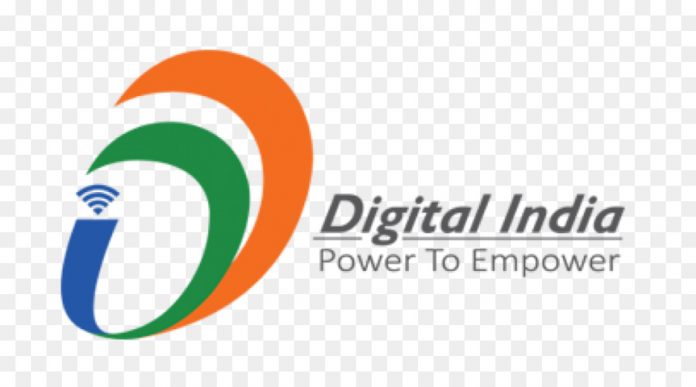This article is written by Meenal Sharma, a student of Vivekananda Institute of Professional Studies. In this article, the author has discussed how Digital India is essential for developing Good Governance.
Table of Contents
Introduction
Nauroti Devi, a 74-year-old woman from Kishangarh Tehsil, Ajmer, Rajasthan never had the opportunity to obtain a formal education. For a living, she worked at a road construction site as a stone cutter. With the advent of Digital India, today, she is a computer educated sarpanch. She is efficient in MS Word, Excel and knows how to use the internet. She has trained over 700 people in the village including many children for a nominal fee of ₹150-200. The story of Nauroti Devi is just one of many examples of how the Digital India programme has changed the lives of people in rural areas.
According to the 2011 census, 68.84% of the population belonged to rural areas. Whereas according to the World Bank collection of development indicators in 2018, 65.97% of the population lives in rural areas. In a country like India, where the majority of the population lives in rural areas, it is not easy to have access to a smartphone with an internet connection and other facilities like training on how to operate computers and have digital literacy. There is a huge digital gap between urban areas and rural areas. Digital India was launched as an initiative to bridge this gap. It was aimed at improving connectivity as well as awareness in the rural areas so that people can benefit from technology in such areas. The intention of this initiative was to establish a responsive and transparent platform. With the help of this programme, farmers don’t have to make payments in cash, digital literacy is being provided to lakhs of people as a result of which they can carry out various online tasks such as transactions, open bank accounts, digital lockers, book railway tickets etc. Apart from all the advantages, there are certain limitations or disadvantages as well. In this article, we will see to what extent Digital India has been successful, how it has affected governance and its limitations.
What is Digital India
Digital India is a programme launched by the Ministry of Electronics and Information Technology on 1 July, 2015. The tagline of this program is ‘power to empower’. The goal is to transform India into a digitally empowered society and knowledge economy. The objectives of this programme are:
- Digital Empowerment: To create a digitally inclusive society through digital empowerment, i.e. making every person digitally literate.
- Infrastructure: To provide digital infrastructure as a utility to a large number of people.
- Governance reforms: To make government initiatives available to citizens through digital platforms.
According to McKinsey Global Institute, the Digital India initiative has the potential to boost the GDP of India by $355 billion to $435 billion by 2025. This initiative was appreciated by various countries like Australia, Canada, Japan, Malaysia, Singapore, South Korea, the United Kingdom, the United States, Uzbekistan and Vietnam.
Nine pillars of Digital India
- Broadband Highways: This ensures broadband connectivity to a large number of people. This includes:
- Broadband for All – Rural
- Broadband for All – Urban
- National Information Infrastructure (NII)
This refers to creating an optical fibre network and cloud infrastructure across Panchayats to ensure high-speed connectivity.
- Universal Access to Mobile Connectivity: It focuses on filling in the gaps in network connectivity across the country.
- Public Internet Access Programme: This aims to provide access points to the public to access the internet. It provides for setting up CSCs (Common Services Centres) in each Gram panchayat and converting post offices as multi-service centres.
- e-Governance (Reforming Government through Technology): It refers to the integration and re-engineering the government processes through information technology with the objective of making government processes more efficient.
- e-Kranti (Electronic Delivery of Services): The vision of e-Kranti, ‘Transforming e-Governance through transforming Governance’, is to promote mobile Governance and Good Governance in the country.
- Information for All: It refers to:
- Open data platforms where information is easily made available to citizens.
- Social media engagement through which the government can interact with the citizens.
- Online messaging to facilitate information regarding special occasions and events to citizens via SMS and emails.
- Electronics Manufacturing: It aims for manufacturing electronics within the nation and NET ZERO imports by 2020.
- IT for Jobs: Providing training to the youth to avail job opportunities in the IT or ITES sector.
- Early Harvest Programme: it consists of projects to be implemented within a short period of time such as Biometric attendance in Central Government offices, school books to be e-books, government greetings as e-greetings, wifi facilities in universities as well as public, weather and disaster alerts through SMS, a National Portal for lost and found children, standardising email design from the government and securing emails within the government.
Programs launched under Digital India
There are a number of programs launched under Digital India to provide numerous facilities to the citizens. Some of them are:
Aadhar
Aadhar is the key pillar of Digital India. A 12 digit unique identification number is provided to every resident and it has a biometrics identification system that stores the photograph, iris scan and fingerprints and demographic details such as residence address stored in a centralised database. Mobile number, bank account details, PAN card, Voter ID card, Ration card, LPG connection card etc have to be linked with Aadhar. It is a strategic policy tool for financial inclusion, and reforms in the public sector, budget and increased convenience. It is to be used as a primary identifier to avail various government schemes. It aims for transparency and good governance.
Aarogya Setu App
This application has been launched during the COVID-19 pandemic to provide the necessary updates to the people. It tracks the live COVID-19 cases and provides information relevant in a particular locality.
BharatNet
This project aims to provide Broadband connectivity to improve telecom services using optical fibre across 2.5 lakh Gram panchayats. The Universal Service Obligation Fund (USOF) funds the entire project. This would help to improve internet and telecommunication services across the country and eventually facilitate e-governance, e-health, e-banking, e-education in rural areas. This project will enable both Centre and States to have free rights over the optical fibre network.
BHIM App
BHIM App (Bharat Interface for Money) simplifies transactions using UPI (Unified Payments Interface) by enabling the instant bank to bank payments. It is a fintech innovation that collects money via payment address or mobile number.
BPO Scheme
The India BPO Promotion Scheme (IBPS) is an initiative to incentivize 48.300 seats with respect to BPO/ITES operations across the country for creating employment opportunities for the youth. This would also lead to the growth of the IT/ITES industry by creating a number of direct and indirect jobs. NEBPS (North East BPO Promotion Scheme) is a similar scheme applicable in the North-Eastern region for creating employment for the youth and the growth of IT/ITES industry.
CSCs (Common Service Centres)
Common Service Centres are digital access points operated by a local entrepreneur to provide digital services in the local community. In 2006, Common Service Centres were a cornerstone laid by NeGP (National e-Governance Plan) to ensure e-governance on a massive scale. A Special Purpose Vehicle, Common Service Centre e-Governance Services India Limited, was established to monitor its implementation. This was done to ensure that the scheme is sustainable and the systems are viable.
In 2015, under Digital India, a CSC 2.0 Scheme was introduced to reach various Gram Panchayats across the country. Under this scheme, the goal is to strengthen the existing CSCs as well as establish CSCs in 2.5 lakh Gram panchayats over the country by 2019. CSCs would be run by local entrepreneurs in rural areas. They provide access points for the delivery of various G2C services, public utility schemes, financial, educational, healthcare, services, and other B2C services. Services like Aadhar Card, Computer and Language Training, E-banking, etc will be made available through these CSCs.
Digi Locker and UMANG (Unified Mobile Application for New-age Governance)
The service of the digital locker was launched to store important records in a cloud network such as Voter ID, Driving License, Aadhar Card, PAN card, education certificates, etc. This is an initiative to inculcate paperless services. UMANG is an application that facilitates a single point of access for various government schemes. The primary aim is to abridge the inconvenience of users in managing various applications.
Farmer Portal, FMS (Fertiliser Monitoring System), MKISAN, AgriMarket App
These programs under Digital India are focused upon resolving the grievances of farmers. Farmer Portal is a one-stop-shop for farmers, which is a single portal to access relevant information and services related to agriculture, animal husbandry, fisheries production, sale as well as storage. The FMS software contains information about the fertilisers, their rates of concessions and MRP at various destinations. MKISAN is an SMS portal which empowers the Centre and State Government organisations related to agriculture and allied sectors to provide information or services to farmers through SMS in their language or preferential agriculture practice and location. AgriMarket App helps in preventing farmers from carrying out distress sales. With the help of this application, they get information relating to the price of crops in markets within 50km of their location.
GeM (Government eMarketplace)
It is a platform which provides goods and services by government organisation, departments, and public sector undertakings which aims to enhance transparency and efficiency in public procurement. Services such as e-bidding, reverse e-auction are made available through this platform.
MYGOV
This is a platform where the common citizen can express their views and give suggestions on governance. This is an interface for a healthy exchange of ideas so that the common citizen can participate in the development of the country.
NCOG (National Center of Geo-Informatics)
It is a system based on Geographic Infosystem. It is a system which has the potential to usher in the era of good governance by improving planning, decision making, delivering electronic services and facilitating location-based information.
PMGDISHA (Pradhan Mantri Gramin Digital Saksharta Abhiyaan)
In 2014, the National Digital Literacy Mission (NDLM) or DISHA (Digital Saksharta Abhiyan), was launched to provide digital literacy training in rural and urban areas to 52.5 lakh people. This target was achieved by December 2016 via CSCs. PMGDISHA is a scheme to make 6 crore people in India by 31st March 2019. It aims to reach around 40% of the rural households by training one member from a household that is eligible under the scheme. It focuses on marginalised sections such as Scheduled Castes (SCs) and Scheduled Tribes (STs), differently-abled people, minorities and women. In this 20 hour course, basics of computers, devices, usage of computers, etc. are taught. The outcomes of the course are defined, i.e., the candidates have to carry out 5 digital transactions using Paytm or other similar software. They have to open their digital locker, give a typing test, open a digital bank account and avail government services like booking a railway ticket. After these activities, the candidates have to give an exam which is a remote proctoring examination system.
PMJDY (Pradhan Mantri Jan-dhan Yojana)
It is an initiative to bring about financial inclusion of households all over the country. It aims for the people to attain financial literacy, banking facilities (one basic banking account in every house) and access to insurance and pension facilities. It envisages to push the Direct Benefits Transfer scheme of the Central Government and ensure that benefits from the Centre or State Government or Local Body directly to the account of the beneficiary.
RAS (Rapid Assessment System)
It is a platform which allows citizens to submit feedback for government services.
RAISE 2020 (Responsible AI For Social Empowerment)
It is a new campaign recently introduced by the Ministry of Electronics and Information Technology with the aim to position India as the AI destination of the world. The objective of this campaign is to unveil India’s vision for AI which is to have a transformational role to advance AI globally. It aims to launch an action roadmap to benefit masses. It focuses on showcasing India’s talent and creating national awareness through AI departments in schools, colleges etc.
SWAYAM
Under this platform various MOOCs (Massive Open Online Courses) are provided to facilitate e-education from class 9th to post-graduation. They can be accessed from anywhere at any time.
SWIFT
SWIFT (Single Window Interface For Trade) seeks to prevent traders from approaching various Governmental agencies and save time and money. SWIFT facilitates importers and exporters by allowing clearance of their documents at a single portal.
How far has Digital India been successful
The International Institute for Management Developed measures the World Digital Competitiveness Ranking (WDCR) of 63 countries. It evaluates the economy of a country based on knowledge, technology and future readiness of the country to adapt and explore digital technologies to reform business, government and society.
In 2015, India was in the 53rd position. After the Digital India initiative, India has managed to jump up to the 44th position. The performance of the Digital India programme has been summarised in the following points:
- Rise in internet users in rural areas: According to a report by IAMAI (Internet and Mobile Association of India), India has 10% more internet users in rural areas than in urban areas. As of November 2019, there are 227 million active internet users in rural areas, whereas 205 million in urban areas.
- Rise in cashless payments: According to the Reserve Bank of India, in the year 2017-2018, the growth rate of digital transactions was 50.4%, whereas, in 2018-2019, the growth rate was 58.8%. As per RBI, the digital transactions are set to rise four times by 2021. Moreover, to maintain social distancing during the coronavirus pandemic, there has been a further shift towards the use of digital transactions. As of March 2019, digital payment transactions worth ₹332.34 crores were successfully made. ₹79.9 crore worth transactions were carried out through BHIM-UPI application.
- Bharat Net: This programme has reached about 1.29 lakh Gram Panchayats and about 3.40 lakh km of optical fibre has been laid to improve connectivity in remote areas.
- KYC (Know Your Customer): The e-KYC based on Aadhar has made it simple to open a bank account or get a SIM Card.
- UMANG App: This application provides over 643 services of the Centre and 18 States which is available in 13 languages. It is available for iOS, Android, Windows and KaiOS
- PMGDISHA (Pradhan Mantri Grameen Digital Saksharta Abhiyan): This Abhiyan aims to train 6 crore people in digital literacy. Over 2.21 crore people have been successfully trained under this initiative.
- CSCs (Common Service Centre): About 3.76 lakh CSCs are set up in India which provide various G2C and B2C services like booking a railway ticket, banking, payment of bills, telemedicine services, digital training etc.
- Electronic manufacturing: Electronic manufacturing in India has doubled in the last few years.
- Around ₹7.44 lakh crore has been allocated to be used in various schemes set out by the government under Digital India. About ₹1.41 lakh crore has been saved by curbing corruption, leakages and eliminating fake beneficiaries.
How will Digital India help in bringing transparency and Good Governance?
Good governance refers to an ideal situation where the government manages its affairs and resources in such a manner that it produces results which meets the needs of the society. In 2014, Good Governance Day was established to be celebrated on 25th December which is the birth anniversary of our former Prime Minister, Atal Bihari Vajpayee. According to the UN E-Government Index 2018, India was on the 96th position. Since 2015, when India ranked 53rd, India has jumped 22 points after the Digital India initiative.
The Digital India initiative promises to ensure Good Governance by formulating schemes which help to enforce the characteristics of Good Governance. The following are the characteristics of Good Governance:
- Rule of Law: Good Governance requires a fair legal framework and the presence of independent and affordable judiciary.
- Transparency: Information must be provided to those who are affected by the decision and policy making of the government. Such information shall be easily accessible as well as free. Moreover, there should be no secrecy in decision making by the government.
- Responsiveness: Good Governance means catering to all its stakeholders within a reasonable period of time.
- Consensus oriented: It is very important to consider the opinion and interests of the people and take decisions which cater to the best interests of the stakeholders.
- Social Equity and Inclusiveness: To ensure equal growth, development must take place in every area. Therefore, it is important to include the weaker sections. The voice of marginalised groups should not be left unheard.
- Accountability: The organisation or government must be accountable to those who are affected by its decisions.
- Efficiency and Effectiveness: Resources must be used judiciously to achieve the desired objective. That is to say that the resources of society should be used in such a way that they take society forward, in the right direction.
- Participation: This refers to the participation of the people in decision making. Good Governance ensures organised and informed participation directly by the people or through representatives.
Attaining Good Governance through e-Governance
With the advent of Digital India, the expectations from the government have increased. It is necessary to resort to digital measures as governance has become very complex. Digital India is instrumental to pioneer Good Governance. It can be attained through e-Governance which can ensure transparency and efficiency.
e-Governance is the process of applying information and communication technology to avail of various governmental services such as transactions, providing information to citizens through portals. It also includes strengthening and integration of the existing digital services. Electronic technologies can be used to facilitate public action such as the relations between public authorities and the civil society, provide electronic public services etc. The pillars of e-Governance are people, process, technology and resources. They can be strengthened by digitising the following:
- e-Administration: The administrative processes should be converted from paper to online to make it more transparent. Moreover, the administrative offices should be paperless. This could increase the efficiency within the Centre and the State as information can be easily shared between agencies.
- e-Services: Services should be provided online to bring the government closer to the citizens and promote faster delivery of service. This will bring about flexibility and also improve the interface of the government with businesses. e-Services and e-Administration together make e-government.
- e-Democracy: The citizens should be able to participate in the affairs of the government with platforms to provide feedback to the government. Presence of public authorities at all democratic stages will help to create an electronic democracy which can certify transparency and usher accountability.
Various initiatives under the Digital India programme such as Aadhar, Direct Benefit Transfer ensure transparency. If every information is made available online then it will automatically bring about transparency and accountability. MyGov application provides for a platform wherein people can come forward and discuss nation-building. This is a platform to include citizens in governance initiatives. They can directly interact with the government and Central ministries. These initiatives aim to ensure the responsiveness of the government and determine whether their policies are in line with the consensus of the stakeholders. Various other programmes under Digital India such as BharatNet, BPO Scheme are instrumental to ensure efficiency and effectiveness. The main objective of Digital India is to ensure social equity and inclusiveness by reaching out to the poorest and weakest individual and uplifting them.
The CSCs are a major instrument for promoting good governance. They contribute to a digitally inclusive society by ensuring electronic services in rural areas. The CSCs provide high-quality services which are cost-effective. By making the rural population of India digitally literate and enabling them to be at par with the urban population, Digital India can ensure Good Governance.
Good Governance Index
The Minister of Personnel, Public Grievances and Pension, Jitendra Singh, launched the Good Governance Index (GGI) in 2019. This index is used to rank the states and union territories on the quality of their governance. It is a very comprehensive index based on the following factors:
- Agriculture and Allied Sectors
- Environment
- Citizen-Centric Governance
- Public Health
- Public Infra and Utilities
- Commerce and Industries
- Human Resource Development
- Judicial and Public Securities
- Social Welfare and Development
- Economic Governance
The data used to analyse the above-mentioned factors has been derived from sources such as Census of India, National Crime Record Bureau, Reserve Bank of India studies of State Budgets, District Information System for Education, National Sample Survey.
The states and union territories are divided into three categories namely (i) the Big States, (ii) North East and Hill States and (iii) Union Territories.
As per the Good Governance Index 2019, in the Big States category, Tamil Nadu was ranked number 1 with a score of 5.62. In Northeast and Hill categories, Himachal Pradesh was at the top, with a score of 5.22, whereas in the category of Union Territories, Pondicherry was at the top with a score of 4.69.
Challenges to Digital India and e-Governance
The following are the challenges faced by the government in the implementation of Digital India and e-Governance:
Economic Challenges
- Cost: Establishing e-Governance infrastructure requires a lot of public expenditure which is a major barrier faced by the government in the successful realisation of Digital India
- Digital Divide: There is a huge digital divide in India between the rich and the poor and between the urban and rural areas. The government needs to narrow the gap to enhance the quality of governance so that it can reach a maximum number of people.
- Slow Execution: Even though the execution of the schemes under this initiative is being carried out at a large scale, they are behind schedule. The targets set under various schemes have not been achieved per se however significant progress is being made.
Technical Challenges
- Internet Connectivity: In urban areas, low internet connectivity is often experienced and it usually takes days to fix the issue. If such a situation arises in rural areas, are adequate resources available to them to solve the problem quickly? Another question that arises is how can digitisation take place in rural and primitive areas where there is no access to electricity?
- Cyber Crime: With the increase in digitisation, increase in cyber crimes is inevitable. Cybercrimes such as online frauds, cyberbullying, identity theft, cyber terrorism, online harassment, pornography and many other crimes will increase with the advent of digitisation. Laws should be implemented strictly. Moreover, spreading fake news through online platforms should also be looked into.
- Need for data protection law: With more and more use of technology which requires sharing data on the internet, it is likely that personal information is likely to get misused. In Justice Puttaswamy (Retd.) and Anr. v Union of India and Ors, the Supreme court has held that Aadhar does not violate the right to privacy of individuals, nevertheless, there is a need for data protection law which correctly addresses the privacy-related harm and privacy concerns of individuals to prevent misuse of personal data.
Social Challenges
- Awareness of e-Governance: Good Governance requires the participation of the people. The utilisation of human resources cannot be done efficiently unless people are aware of how to use it. People are not aware of the concept of e-Governance. Awareness about e-Governance is lacking in both rural and urban areas.
- Local Languages: There are 22 languages in India and technology is accessible in very few of them. To reach out to the maximum number of people, technology has to be available in every local language.
- Fake News: Through digital platforms, there is an increase in the spread of fake news by people who want to impose their opinions. This is a major disadvantage of technology that denies Good Governance.
It has been 5 years since the launch of Digital India. The project has outgrown its nascent stage, however, a lot still needs to be done. Significant progress has been made but the above-mentioned challenges still lie ahead.
Recommendations
The Digital India initiative has a long way to go for bridging the gap between urban and rural areas. The need of the hour is to ameliorate the existing infrastructure to build a stronger base. It is essential to establish government service which can be provided with ease similar to that of online shopping. Why is it that purchasing something online is much easier than availing government services online? The government should focus on making the existing systems more efficient before spreading to other areas. Moreover, the major gap between urban and rural areas is due to the cause of mobility. Technology should focus on eradicating the problems which are caused due to a lack of mobility. Finally, the schemes laid by the government at the institutional level, such as the adoption of UIDAI and digital technology are extrinsic measures which are being taken to improve governance. However, what is needed is to inculcate intrinsic measures, i.e. the practice of self-governance. The extrinsic measures to ensure governance will be fruitful only when intrinsic measures are being taken. It is very important to have moral values, such as practising honesty and integrity. If such intrinsic measures are ensured by the employees of the government then good governance would become inevitable. As Mahatma Gandhi said, ‘Be the change you wish to see in the world’, real change can only come by practising righteousness.
Conclusion
Digital India is a people’s movement. By this movement, people will be empowered by their own efforts. After the British rule, India became a poverty-stricken economy. Even today after 72 years of independence, poverty is the main obstacle in India’s growth. Through Digital India, more jobs are being created and people are getting encouraged to stand on their own feet.
In a country like India which is an agriculture-based economy, the efforts made to empower farmers through digitisation can be revolutionary if fully implemented. Providing services such as real-time prices information and online ordering, applying for loans, insurance etc to farmers can ease their work to a great extent. It can put to rest numerous hardships faced by the farmers.
Other schemes such as Common Service Centres are an excellent way to promote entrepreneurship by local people in rural areas. In India, the majority of the population resides in rural areas. Therefore we need to uplift the people in these areas for overall development. Overall development can be achieved only through the inclusion of citizens which is a major objective of the Digital India programme. Multidisciplinary reforms are needed to include the participation of the maximum number of citizens. The effort to inculcate digital literacy in every person is commendable.
The population of India mainly consists of young people. If Digital India is correctly used to target the youth, this project can be a huge success. Also, cyber crimes are the major enemies of this program. Therefore, a good and effective law must be constructed to curb these crimes to the greatest possible extent. Other issues like corruption can be eradicated through transparency and accountability which are the key objectives of Good Governance.
The government has achieved the objectives of Digital India to a great extent but they still have a long way to go to create a significant and effective impact. All in all, Digital India is the much-needed amelioration that can put India on the track of development through inclusion.
References
- https://censusindia.gov.in/2011-prov-results/paper2/data_files/india/Rural_Urban_2011.pdf
- https://tradingeconomics.com/india/rural-population-percent-of-total-population-wb-data.html
- https://www.mckinsey.com/~/media/mckinsey/business%20functions/mckinsey%20digital/our%20insights/digital%20india%20technology%20to%20transform%20a%20connected%20nation/digital-india-technology-to-transform-a-connected-nation-full-report.ash
- https://www.digitalindia.gov.in/di-initiatives
- https://www.drishtiias.com/daily-updates/daily-news-analysis/good-governance-day#:~:text=Good%20Governance%20Index,the%20State%20Government%20and%20UTs.
LawSikho has created a telegram group for exchanging legal knowledge, referrals and various opportunities. You can click on this link and join:
 Serato DJ Crack 2025Serato DJ PRO Crack
Serato DJ Crack 2025Serato DJ PRO Crack











 Allow notifications
Allow notifications



